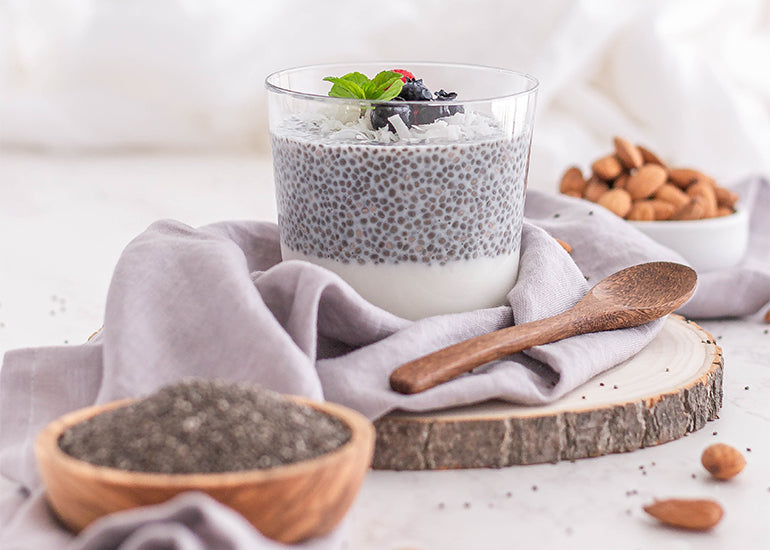Learn why this power food is an environmental and nutritional superstar, making it so worthy of a resounding Ch-ch-ch-chia!
The environmental impacts of agriculture for food production should not be downplayed. Food production accounts for over a quarter of global greenhouse gas emissions, making it a crucial driver of climate change, and about half of the world’s habitable land is used for agriculture which has contributed significantly to biodiversity loss. That makes it more important than ever to make wiser food choices that are less demanding on the planet. Enter a tiny seed called chia.
Being somewhat drought resistant, it grows robustly in arid regions with low-quality soils and requires little, if any, irrigation once established, making chia less of a water hog than many other crops, including nuts and certainly livestock production. The water footprint of the food we eat gets little press but is a matter of utmost importance for planetary health and future generations. What’s more, the essential oils in chia seeds, which come from an annual herbaceous plant, Salvia hispanica L., a member of the mint family native to Mexico and Central America, are thought to be a natural repellent to insects, so the use of chemical inputs like pesticides are not required to produce healthy crops. This is why chia is an excellent candidate for organic certification. Chia plants that are grown using organic methods can be considered a regenerative crop which means it helps restore the soil in which it’s planted. Soil health is paramount when it comes to adequately feeding a growing population in the decades to come. Overall, chia is one of the most ‘sustainable’ plant-based foods you can put on your grocery list.
Not only are organic chia seeds good for the health of the planet but they are also up to the task of improving our health as well. For starters, only about 11% of the fat present in chia seeds is saturated, with the rest being health-benefiting monounsaturated and polyunsaturated. In the case of chia, the most notable polyunsaturated fat is alpha-linolenic acid (ALA), a form of omega-3 fatty acid that is essential to human health and therefore must be obtained from the diet. An analysis of data from 41 studies published in The BMJ linked a high intake of alpha-linolenic acid to a 10% lower risk of all-cause mortality, an 8% lower risk of death from cardiovascular disease and an 11% reduced risk of death from coronary heart disease, compared with lower consumption levels. Each 1-ounce serving of chia (about 2½ tablespoons) supplies 5 grams of ALA, which is more than twice the daily requirement for this nutrient.
Far from a one-hit wonder, chia should be considered a fiber heavyweight. A mere tablespoon serving delivers about 4 grams of fiber. The findings of a study published in the prestigious journal The Lancet suggest that people who go bigger on fiber, at least 25 grams a day, have a 15 to 30 percent lower risk of heart attack, stroke, type 2 diabetes, colorectal cancer and cardiovascular-related death compared to people who fail to eat much fiber. It’s worth noting that a good chunk of the fiber in chia is in the form of soluble fiber which is particularly impactful when it comes to blood sugar regulation and keeping cholesterol numbers in the healthy range.
For more proof that good things come in small packages, chia delivers a trio of micronutrients needed to maintain healthy bones: calcium, magnesium and phosphorus. Nutrition analysis has revealed that chia seeds deliver a range of useful antioxidants including caffeic acid, rosmarinic acid, myricetin, and quercetin. Antioxidants are compounds that roam the body looking for cell-damaging free radicals to sequester and render less harmful.
How to Eat Your Chia
Chia seeds have a very mild flavor and can be added to both sweet and savory dishes. Eating more chia can be as simple as sprinkling a generous amount over your oatmeal, yogurt, salads and roasted vegetables. You can also whiz them into your smoothies for a nutritional boost and incorporate them into homemade granola bars and energy balls.
A very common way to use chia is to make a pudding, which can be flavored in all sorts of ways. The high amount of soluble fiber in chia forms a gel when mixed with liquid. A quirk that you can take advantage of to also create better-for-you fruit jams. The same gelling quality lets you create a substitute for eggs in baking recipes like muffins. For each egg called for in a recipe, mix 1 tablespoon chia seeds with 3 tablespoons water and let sit for about 10 minutes, or until a goopy texture has formed. Now it can be used to create a binding effect much as an egg would.
Chia powder, which is nothing more than finely ground chia seeds, can be added to baked goods like muffins and cookies as well as pancake batter. Even try it instead of breadcrumbs in recipes such as veggie burgers or stir the nutrient-dense powder into a pot of simmering oats.
Chia Crusted Tofu Recipe
Chia seeds lend tofu a crunchy crust that is packed with nutrition.
INGREDIENTS
1 block extra-firm tofu
¼ cup Navitas Organics Chia Seeds
⅛ tsp. cayenne pepper
Zest of 1 lime
½ tsp. salt
¼ tsp. black pepper
1 Tbsp. toasted sesame oil
2 tsp. avocado, canola or grapeseed oil
DIRECTIONS
- Rinse tofu under cold water and slice in half lengthwise. Wrap it in a double layer of paper towel and place on a plate. Place a second plate or cutting board on top of the tofu, and weigh it down with something heavy like a cast-iron skillet. Let sit at least 15 minutes to drain out any excess water.
- On a plate, mix together chia seeds, cayenne, lime zest and salt and pepper.
- Slice tofu pieces into halves crosswise so you have four pieces of tofu and brush each side with sesame oil. Press each side of the tofu into the chia mixture to coat thoroughly.
- Heat oil in a skillet over medium heat. Sear the tofu blocks until crisp and golden brown, about 5 minutes on each side.
Granola Blueberry Chia Pudding Recipe
This make-ahead plant-based pudding is your answer to an ultra-quick breakfast that packs a nutritional punch.
INGREDIENTS
⅓ cup unsweetened dairy-free milk of choice
1 package (12 ounces) soft or silken tofu
1 cup fresh or frozen (thawed) blueberries, plus more for topping
2 tsp. honey or pure maple syrup
1 tsp. vanilla extract
½ tsp. cinnamon
6 Tbsp. Navitas Organics Chia Seeds
⅔ cup low-sugar granola
¼ cup chopped nuts of choice
DIRECTIONS
- Place milk, tofu, blueberries, honey, vanilla, cinnamon and a pinch of salt in a blender container and blend until smooth.
- Divide mixture between 2 wide-mouth jars and stir 3 tablespoons chia seeds into each jar. Seal shut and chill overnight to thicken.
- When ready to serve, top each jar with and equal amount of granola, nuts and fresh blueberries.
)

